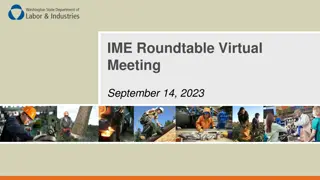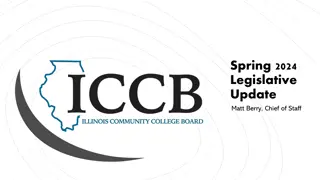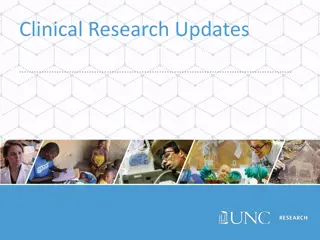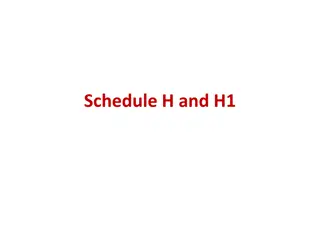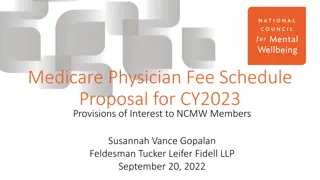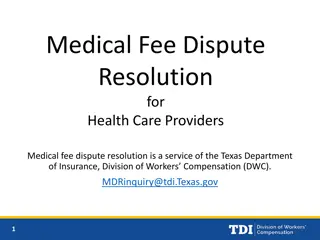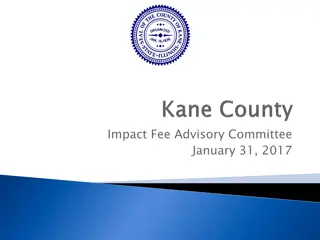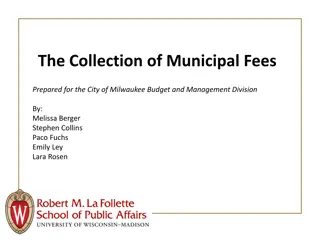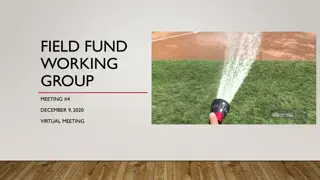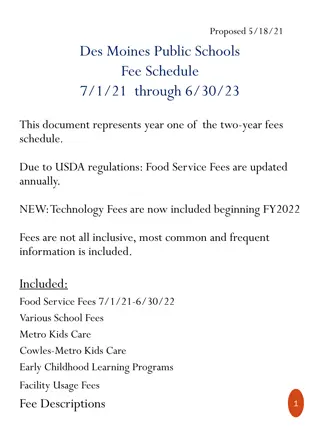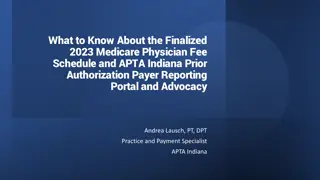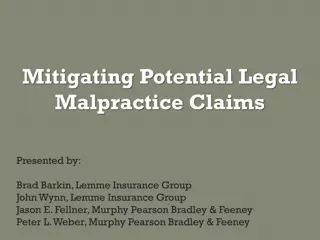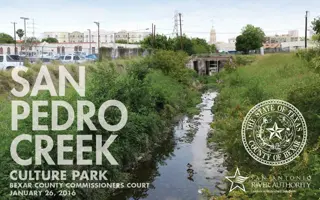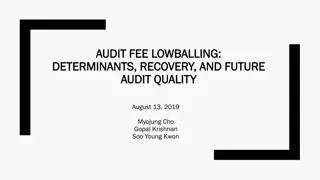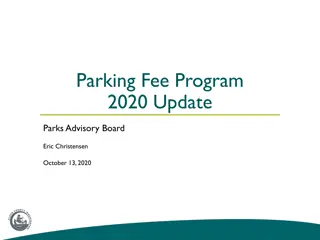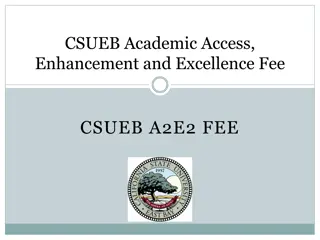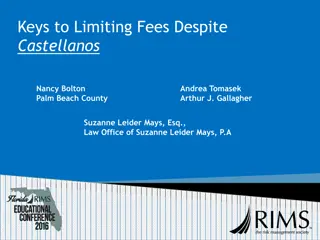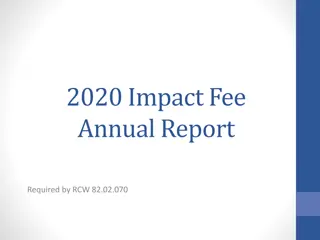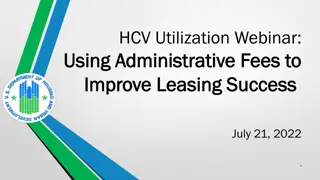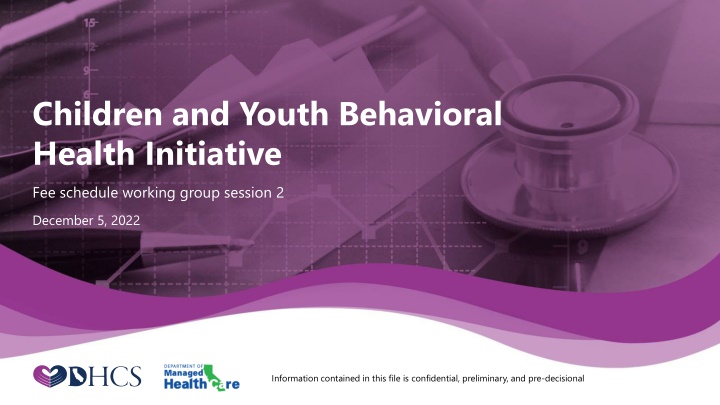
Behavioral Health Initiative Fee Schedule Working Group Session Overview
This document contains confidential, pre-decisional information from a working group session discussing the scope of services in a fee schedule related to children and youth behavioral health initiatives. The session focuses on aligning objectives, reviewing key topics, sharing hypotheses on services, discussing potential support for schools, and outlining a vision for a future-state all-payer school-linked fee schedule. Participant expectations, objectives, and decision-making processes are also detailed.
Download Presentation

Please find below an Image/Link to download the presentation.
The content on the website is provided AS IS for your information and personal use only. It may not be sold, licensed, or shared on other websites without obtaining consent from the author. If you encounter any issues during the download, it is possible that the publisher has removed the file from their server.
You are allowed to download the files provided on this website for personal or commercial use, subject to the condition that they are used lawfully. All files are the property of their respective owners.
The content on the website is provided AS IS for your information and personal use only. It may not be sold, licensed, or shared on other websites without obtaining consent from the author.
E N D
Presentation Transcript
Children and Youth Behavioral Health Initiative Fee schedule working group session 2 December 5, 2022 Information contained in this file is confidential, preliminary, and pre-decisional
Information contained in this file is confidential, preliminary, and pre-decisional Topic Activities Time Session overview and review of last Fee Schedule Workgroup session Align on today s objectives Review key topics from Workgroup session 1 20 mins 1 DRAFT AS OF 11/29/22 Today s Agenda Scope of services in the Fee Schedule Share current hypothesis on scope of services Discuss services which may be included in the scope of the fee schedule 40 mins 2 Break 5 mins Potential support needed for schools Discuss the potential support which schools may need to utilize the fee schedule 55 mins 3 2 Source: DHCS offline input as of 11/19/22
Information contained in this file is confidential, preliminary, and pre-decisional DRAFT AS OF 11/29/22 1. Recap: Vision for a future-state all-payer school-linked fee schedule1 To leverage the CYBHI fee schedule as a sustainable funding source for school-linked BH services that: Increases access to school-linked BH services for children and youth Creates a more approachable billing model for schools and local educational agencies (LEAs)2 Eases burdens related to contracting, rate negotiation, and navigation across delivery systems Reduces uncertainty around students coverage 1. Additional definitions of organizations included as payers in the all- payer, school-linked fee schedule to be provided by DHCS. According to California Health and Safety Code section 1374.22, a local educational agency means a school district, county office of education, charter school, the California Schools for the Deaf, and the California School for the Blind. 2. 3 Source: DHCS 2022 stakeholder engagement sessions
Information contained in this file is confidential, preliminary, and pre-decisional 1. Recap: Fee schedule working group charter Objectives and scope DRAFT AS OF 11/29/22 The Workgroup will: The Workgroup will not Member expectations Provide perspectives on current-state processes forschool-linked BH services billing / reimbursement / contracting, including potential challenges Offer perspectives on select design decisions, including (not exhaustive): What services are included in the fee schedule? Who is eligible to provide services? How are payments made through the fee schedule? Discuss the fee schedule implementation plan Make final design decisions (DHCS and DMHC will decide) Complete all pre-work and pre-reading before sessions as needed Join all Workgroup sessions on-time Do not multi-task during sessions Maintain confidentiality Provide input on rates for services in the fee schedule Directly shape decisions around changing or replacing other billing programs (e.g., LEA BOP) 4 Source: Discussion with OSP, 09/07/2022; 08/17/2022
Information contained in this file is confidential, preliminary, and pre-decisional 1. Recap: Fee schedule working group norms and values DRAFT AS OF 11/29/22 Participatory Commit to participating in discussions, completing pre-work , and joining potential follow-up sessions Collaborative Work together to facilitate the program design by welcoming others perspectives and championing CYBHI Solution- oriented Anchor discussion on problem solving and brainstorming potential solutions Open and exploratory Maintain a safe space for discussion, debate, questions, and risk-taking Health impact- focused Center around the impact and outcomes of design decisions for children, youth, and families in California Inclusive Celebrate each other s lived experience and ensure all groups feel comfortable engaging (e.g., by avoiding acronyms) Data-driven Consider pathways to measuring success 5 Source: DHCS Think Tank sessions
Information contained in this file is confidential, preliminary, and pre-decisional Fee Schedule Workgroup session 1 discussion topics DRAFT AS OF 11/29/22 The Workgroup discussed opportunities for a fee schedule to improve behavioral health services and systems and considerations around policy and operational considerations, including: Expanding accessibility and quality of behavioral health services for students Increasing sustainability of funding for behavioral health services in schools Streamlining administration and billing process for schools that provide behavioral services Increasing the volume of funding available for behavioral health services Encouraging lasting partnerships between schools and behavioral health providers Simplifying credentialing and enrollment mechanisms 6 Source: DHCS & DMHC Fee Schedule Workgroup meeting, 10/24/2022
Information contained in this file is confidential, preliminary, and pre-decisional DRAFT AS OF 11/29/22 1. Current hypothesis for future-state school-linked fee schedule process flow LEA, IHE, or BH provider enrolls in school-linked provider network Provider delivers services at or near school site Responsible party submits claim for reimbursement Plan remits payment at the established rates State conducts ongoing audit and accountability LEA, IHE or contracted BH provider bills directly for services LEA or IHE enrolls as a school-linked network provider and hires eligible2 BH practitioners LEA or IHE contracts with BH providers, which enroll separately as network providers LEA or IHE provides or arranges for the provision of eligible medically necessary services on or near campus, mobile, etc. Relevant payer1 remits payment the established all- payer rates State monitors for appropriate and timely reimbursement and fraud, waste, and abuse LEA or IHE uses third party administrator to bill for services 1. 2. E.g., Managed Care Organizations (MCOs), County BH, Commercial plans Eligible providers for reimbursement for specific services will be included in the scope of services of the fee schedule. 7 Source: DHCS input as of 11/02/2022
Information contained in this file is confidential, preliminary, and pre-decisional 2. Guiding principles for services included in the fee schedule DRAFT AS OF 11/02/22 DRAFT AS OF 11/29/22 Guiding principles: Services included in the state-wide, all-payer school-linked fee schedule are meant to directly impact or enable student health outcomes. Services in the fee schedule:1 Are currently reimbursed or reimbursable under existing State or Federal authorities Are sufficiently suitable to provide to students in school settings and additive to services provided elsewhere Will NOT involve classroom-based services delivered by an ineligible practitioner type (e.g., teachers) Will NOT duplicate services which schools are currently required to provide under State or Federal authorities 1. Guiding principles were developed based on a DHCS OSP working session held on 10.26.2022 8 Source: DHCS OSP working sessions on 10/18/2022 and 10/26/2022; DHCS leadership offline input 10/17/2022
Information contained in this file is confidential, preliminary, and pre-decisional 2. Overview of potential scope of services which may be included in the fee schedule1 DRAFT AS OF 11/29/22 The current, preliminary hypothesis from DHCS and DMHC is that the following services may be included in the fee schedule Category Prevention / early intervention Group / individual peer services Group wellness education and skill-building Health education by Community Health Workers Individual preventative wellness and skill- building Pre-clinical SUD intervention Screenings (initial) Screenings (secondary) Student discussion/ support groups Potential service2 Family-based behavioral health education SUD screenings Category Treatment Potential service2 Assessments Evidence-based therapy, CBT Group therapy Individual therapy SUD Group counseling SUD Individual counseling SUD Physician consultation Team consultation Case consultation Care coordination 1.Based on input from DHCS leadership received 10/17/2022 2.The overall list of potential services is based on the scope of services spreadsheet sent by Manatt on 10/5/2022 9 Source: DHCS and DMHC stakeholder conversations ; Expert interviews ; Agency for Healthcare Research and Quality (AHRQ)
Information contained in this file is confidential, preliminary, and pre-decisional Workgroup members will now split up into four breakout groups to discuss specific services that may be added to the potential scope of the fee schedule. Breakout topics are: 1. Family & dyadic services 2. Case management 3. SUD services 4. Medication management Each breakout group has the following tasks: 1. Select one member to report out at the end 2. For the group s assigned service, use Jamboard stickies to answer the following questions: A. Is this service suitable and appropriate to provide in school settings? B. What are other considerations around delivery and reimbursement for this service in school settings? DHCS and DMHC facilitators will provide additional instructions and prompts in your breakouts DRAFT AS OF 11/29/22 2. Scope of services breakout group discussions 15 min 10 Source: DHCS offline input as of 11/19/22
Information contained in this file is confidential, preliminary, and pre-decisional DRAFT AS OF 11/29/22 2. Scope of services breakout group readouts Each breakout group s designated reporter should share: Brief overview of the group s topic 1-2 key takeaways from the discussion 10 min 11 Source: DHCS offline input as of 11/19/22
Information contained in this file is confidential, preliminary, and pre-decisional 3. Overview of CYBHI grants for K-12 and higher ed in support of the fee schedule DRAFT AS OF 11/15/22 FOR DISCUSSION DRAFT AS OF 11/29/22 Focus for today s discussion Discussion today will focus on some of the specific mechanisms to support educational institutions in billing under the fee schedule The CYBHI includes $600M+ in one-time grants to strengthen school- linked behavioral health services and provide California public K-12 and higher education institutions with resources to support:1,2 1. K-12 grants3(~$400M) 2. Higher education grants4(~$150M) 3. Mindfulness and wellbeing grants5(~$65M) One goal of the grants is to support institutional readiness for the fee schedule, including, e.g.: Infrastructure that provides mechanisms and technology to regulate billing and reimbursement for behavioral health services at or near school locations Capacity for staff to manage billing and reimbursement processes Partnerships with organizations that facilitate efficient billing and reimbursement for schools Sources: (1) See Children and Youth Behavioral Health Initiative Act, 5961.4 (a) (1) (4); refer to the Act for official text; (2) California Health and Human Services Agency; (3) For publicly funded schools, charter schools, California School for the Deaf, California School for the Blind, and Bureau of Indian Education schools; (4) For publicly funded higher education institutions: University of California system, California State University system, and California Community Colleges; (5) Partnership with CalHOPE and Sacramento County Office of Education to support student mindfulness and wellbeing 12
Information contained in this file is confidential, preliminary, and pre-decisional DRAFT AS OF 11/29/22 3. Fee schedule supporting mechanisms breakout group discussions Workgroup members will now split up into breakout groups with the following tasks: 1. Select one member to report out at the end 2. Brainstorm potential supporting mechanisms for educational institutions to participate in billing for services under the fee schedule (15 mins) 3. Discuss the brainstormed services and group them into 3-4 overarching categories (10 mins) 25 min DHCS and DMHC facilitators will provide additional instructions in your breakouts 13 Source: DHCS offline input as of 11/19/22
Information contained in this file is confidential, preliminary, and pre-decisional DRAFT AS OF 11/29/22 3. Fee schedule supporting mechanisms breakout group readouts Each breakout group s designated reporter should share: The 3-4 categories of support mechanisms identified by the group 1 theme or takeaway from the discussion 15 min 14 Source: DHCS offline input as of 11/19/22
End page Information contained in this file is confidential, preliminary, and pre-decisional

